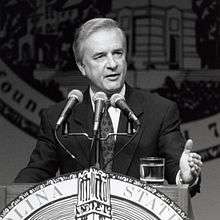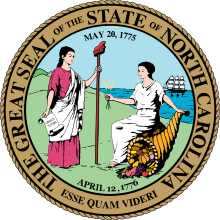Jim Hunt
| Jim Hunt | |
|---|---|
 Jim Hunt speaks at North Carolina State University in 1992 | |
| 69th and 71st Governor of North Carolina | |
|
In office January 9, 1993 – January 6, 2001 | |
| Lieutenant | Dennis A. Wicker |
| Preceded by | James G. Martin |
| Succeeded by | Mike Easley |
|
In office January 8, 1977 – January 5, 1985 | |
| Lieutenant | James C. Green |
| Preceded by | James Holshouser |
| Succeeded by | James G. Martin |
| 27th Lieutenant Governor of North Carolina | |
|
In office January 6, 1973 – January 8, 1977 | |
| Governor | James Holshouser |
| Preceded by | Hoyt Patrick Taylor, Jr. |
| Succeeded by | James C. Green |
| Personal details | |
| Born |
James Baxter Hunt, Jr. May 16, 1937 Greensboro, North Carolina |
| Political party | Democratic |
| Spouse(s) | Carolyn Hunt |
| Children | 4 |
| Education |
North Carolina State University University of North Carolina |
| Profession | Farmer, lawyer, politician |
James Baxter "Jim" Hunt, Jr. (born May 16, 1937) is an American politician who was the 69th and 71st Governor of North Carolina (1977–1985, and 1993–2001). He is the longest-serving governor in the state's history. Hunt is tied for the fourth-longest gubernatorial tenure in post-Constitutional U.S. history at 5,840 days.[1]
Early life
Hunt was born in Greensboro, North Carolina and raised in Wilson, North Carolina.
He is a graduate of North Carolina State College, now known as North Carolina State University, with a B.S. in agricultural education and a M.S. in agricultural economics. During his undergraduate career, Hunt was involved in Student Government. He was the second student to serve two terms as Student Body President of NC State.[2] In 1964, he received a J.D. from the University of North Carolina School of Law. He went on to serve as the President of the Young Democratic Clubs of North Carolina, now known as the Young Democrats of North Carolina.
Political career

Hunt is the only Governor of North Carolina to have been elected to four terms. He was first elected Governor in 1976 over Republican David Flaherty and was re-elected in 1980, defeating I. Beverly Lake. He previously served a term as the 27th Lieutenant Governor (1973–1977) under Republican Governor James Holshouser. Hunt supported a constitutional change during his first term that allowed him to be the first North Carolina governor to run for a second consecutive term.
Hunt Commission
In 1981 Hunt chaired the Hunt Commission, named after himself, which established superdelegates in the Democratic National Convention.[3]
U.S. Senate Run
In 1984 he lost a bitterly contested race for the U.S. Senate seat held by Jesse Helms, and left elective politics for several years. He returned in 1992 and defeated Republican Lt. Governor and Hardees executive Jim Gardner to win the Governorship. Hunt was re-elected by a large margin over future US Congressman Robin Hayes in 1996. He left office in January 2001, and was replaced by fellow Democrat, Attorney General Mike Easley.
Actions and political views

In the 1970s Governor Hunt was a supporter of the Equal Rights Amendment and, with his wife Carolyn, he urged its approval by the state legislature (which failed to ratify it by two votes). Hunt was an early proponent of teaching standards and early childhood education, gaining national recognition for the Smart Start program for pre-kindergarteners. In his book, First in America: An education governor challenges North Carolina, Hunt says that under testing and accountability measures he put into place test scores went up. He says 56% of students were proficient in 1994 compared with 70% in the year 2000. He says without testing students slip through the cracks and face a "limited future" (p. 55). In 2000 he was mentioned as a possible Democratic nominee for Vice President of the United States[4] or Education Secretary for Al Gore had Gore been successful in the 2000 presidential race. 2004 Democratic nominee Sen. John Kerry was likewise considering Hunt for Secretary of Education had he won, and he was considered a candidate to be Barack Obama's Secretary of Education.[5]
Hunt served on the Carnegie Task Force, which created the National Board for Professional Teaching Standards and more recently on the Spellings Commission on the Future of Higher Education.
As governor, Hunt was involved in a variety of efforts to promote technology and technology-based economic development, including the establishment of the North Carolina Biotechnology Center, and the North Carolina School of Science and Mathematics. He was also very successful at recruiting business to his state.
Hunt was criticized for allowing Darryl Hunt (no relation known) to remain in prison for twenty years after the wrongfully convicted Winston-Salem man was exonerated by exculpatory DNA evidence which pointed to another perpetrator. Darryl Hunt was pardoned by the succeeding Governor, Mike Easley. During his terms in office Hunt oversaw 13 executions (two during his first period in office, 11 during his second), including the first post-Furman execution of a female (Velma Barfield) and the first post-Furman execution in North Carolina (James W. Hutchins).
Retirement
Hunt currently is a member of the law firm of Womble Carlyle Sandridge & Rice PLLC, in its Raleigh office. He also enjoys spending his time on his farm looking after his Simmental Cattle and miniature pony Herby.
Hunt chairs the Board of Directors of two institutes which he founded, The James B. Hunt, Jr. Institute for Educational Leadership and Policy at UNC-Chapel Hill, and the Institute for Emerging Issues at N.C. State University in Raleigh.[6] He also serves on the North Carolina Advisory Board of DonorsChoose.
Legacy
- The following are named for Governor Hunt:
- James B. Hunt, Jr. Library at North Carolina State University Centennial Campus
- James B. Hunt High School in Wilson County, North Carolina
- James B. Hunt, Jr. Residence Hall at North Carolina School of Science and Mathematics
- James B. Hunt Horse Complex at the North Carolina State Fairgrounds is used year-round for horse shows and other agricultural exhibitions.
- The M/V Gov. James B. Hunt, Jr. is the primary ferry on the Currituck Sound route, making daily runs between Currituck and Knotts Island, operated by the North Carolina Department of Transportation Ferry Division
- An authorized biography of Hunt, authored by former press secretary Gary Pearce, was released in the fall of 2010.
References
- ↑ Ostermeier, Eric (April 10, 2013). "The Top 50 Longest-Serving Governors of All Time". Smart Politics.
- ↑ Historical State: History in Red and White. "James Baxter Hunt, Jr.". Retrieved December 21, 2011.
- ↑ Magnuson, Ed; Allis, Sam (February 20, 1984). "Primed for a Test". Time. Retrieved May 6, 2010.
- ↑ "Gore considering naming VP immediately after GOP convention". CNN. July 14, 2000. Retrieved June 8, 2008.
- ↑ http://news.yahoo.com/s/ap/20081107/ap_on_el_pr/obama_potential_appointees
- ↑ "National Advisory Board". Institute for Emerging Issues. Retrieved December 8, 2012.
External links
- News & Observer profile
- Womble Carlyle Sandridge & Rice, PLLC Biography
- UNC-TV: Biographical Conversations with James B. Hunt, Jr.
- Past Winners of Harold W. McGraw, Jr. Prize in Education
- Oral History Interviews with James B. Hunt , , from Oral Histories of the American South
- James B. Hunt Political Campaign Audiovisual Material, 1980–1997
| Political offices | ||
|---|---|---|
| Preceded by Hoyt Patrick Taylor, Jr. |
Lieutenant Governor of North Carolina 1973–1977 |
Succeeded by James C. Green |
| Preceded by James Holshouser |
Governor of North Carolina 1977–1985 |
Succeeded by James G. Martin |
| Preceded by James G. Martin |
Governor of North Carolina 1993–2001 |
Succeeded by Mike Easley |
| Party political offices | ||
| Preceded by John Ingram |
Democratic Party nominee for United States Senator from North Carolina (Class 2) 1984 |
Succeeded by Harvey Gantt |
